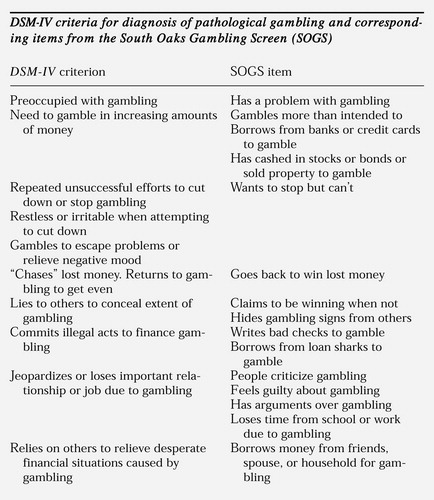Sogs Gambling
The evidence reviewed indicates that the construct of pathological gambling as represented by the SOGS and its variants provides a robust definition and implies that the SOGS meets the important.
Dogs Gambling Painting

Dogs Gambling Picture

| Availability | The instrument is freely available here: South Oaks Gambling Screen (SOGS) |
| Classification | |
| Short Description of Instrument | The South Oaks Gambling Screen (SOGS) is a 20-item self-rated screening questionnaire based on DSM-III criteria for pathological gambling. The SOGS is the most commonly used instrument to screen for pathological or problem gambling in the general population. |
| Scoring | The SOGS has 20 items that are scored 0 or 1, with a total score of 1-4 suggesting problem gambling and a score =5 suggesting pathological gambling. |
| References | Lesieur HR, Blume SB. The South Oaks Gambling Screen (SOGS): A new instrument for the identification of pathological gamblers. Am J Psychiatry 1987;144:1184–1188. |

SOUTH OAKS GAMBLING SCREEN: REVISED FOR ADOLESCENTS (SOGS-RA) The 12 scored items for the SOGS-RA from Winters, K.C., Stinchfield R.D. And Fulkerson, J. (1993a) are listed below. This report provides an overview of the development, validation and reliability testing of the Canadian Problem Gambling Index, developed over the last three years. This research was conducted by a research team under the aegis of the Canadian Centre on Substance Abuse for the Inter-Provincial Task Force on Problem Gambling. SOUTH OAKS GAMBLING SCREEN Please email, mail or fax this form to: Mental Health America of Northeast Indiana Training and Outreach Coordinator 1025 West Rudisill Boulevard Box 8 Fort Wayne, IN 46807 FAX: 260-423-3400 EMAIL: info@mhaac.com If you have questions about the program or this form, please call 260.422.6441. Problem gambling is a prevalent phenomenon in both Finland (studies 1 and 2) and the USA (study 3). Table 1 reports the descriptive statistics for the SOGS-scores. Prevalence of probable gambling disorder (SOGS score ≥ 8) was 3.96% in study 1, 7.80% in study 2, and 4.42% in study 3.